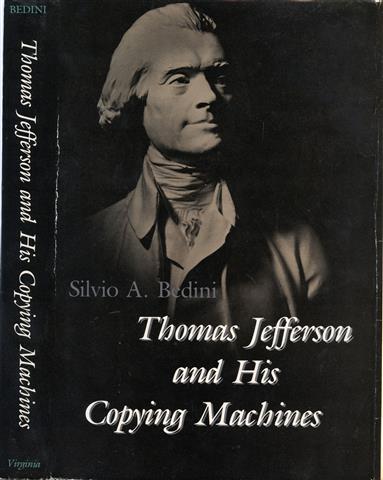
I came across Bedini's fascinating book when I was researching two
boxes which were typical of the sort of box in which Jefferson
interested himself:
Hygra: Antique Rare small traveling Watt's patent copying machine circa 1790
%20(Custom).JPG)
A rare small size mahogany traveling box of
dovetail construction, the compartmentalized interior with a
Watt's patent copying machine circa 1790. The box retains many of
the accessories including the crank handle and a special tool for
adjusting the tension of the rollers. The roller mechanism of
machined brass and steel is particularly interesting in that the
pressure and alignment of the rollers can be adjusted and are connected
to each other by cog-wheels.
Watts was granted a patent in 1780. The patent covered not only the
roller press but also the ink which had to be semi soluble in water.
and
Hygra: Antique Brunel Patent "Polygraph" Circa 1803
%20(Custom).JPG)
Rare Polygraph by I. H
Farthing of Cornhill London to the patent design of Marc Isambard Brunel
(1769-1849)
The box is in the Campaign style, made of solid mahogany using dovetail
joints reinforced with brass corners, straps and edges. The box has
countersunk brass handles. There is a drawer designed to hold the
Polygraph mechanism when not in use. There are seven secret drawers
concealed behind three sprung panels. The box retains its original
inkwells. The Polygraph mechanism which enabled
the movements of one pen to be copied by another is now missing.
|
The book jacket reads:
“Thomas Jefferson’s delight in mechanical copying and writing
devices has been noted by several of his biographers but generally
dismissed as another example of his interest in gadgetry. What has been
overlooked is that these devices made possible the preservation of a large
part of his official papers and correspondence.
Jefferson’s lifelong concern with the maintenance of public records
began when he was a law student in Williamsburg. And, early in his public
career he began duplicating his own writings because he could foresee
their importance to future generations of Americans and historians,
Nowhere is Jefferson’s talent for mechanics and invention more evident
than in his modifications and improvements of the copying machine known as
the polygraph.
His many suggestions are recorded in his correspondence with Charles
Willson Peale and Benjamin Henry Latrobe. The statesman’s mind of work
is revealed as he contemplated, experimented, and recommended changes,
seeking always greater miniaturization for ease of use. He successfully
miniaturized his portable writing desk in 1775 and his portable copying
press in 1786.
His later experiments with reducing the size of the polygraph reflected
his ever present compulsion for the saving of effort, space, and time.
This work is concerned with Jefferson’s writing habits and tools from
his early life to his death and his concern with the preservation of his
writing. Many of these writing tools are described and illustrated,
including quill pens, copying presses, polygraphs, and the “Stylographic
Writer”.
Jefferson and his multiplication of writings form the framework of this
work, within which evolves the general history of copying and writing
methods. Machines and processes from the seventeenth century to the
present, ending with the Xerox machine, are considered, through the pages
parade a galaxy of notables including Benjamin Franklin, Alexander von
Humboldt, James Madison, Mellimelli the ambassador from Tunis, James Watt,
Sir William Petty, Samuel Hartlib, Aaron Burr, and John Beckly.”
|
